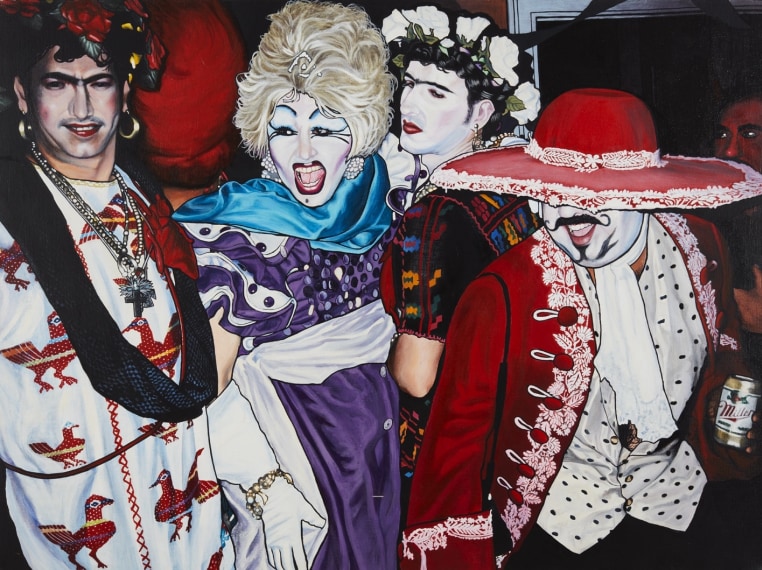
Installation view, Ortuzar, Frieze New York 2025. Photo: Steven Probert
Installation view, Ortuzar, Frieze New York 2025. Photo: Steven Probert
Installation view, Ortuzar, Frieze New York 2025. Photo: Steven Probert
Installation view, Ortuzar, Frieze New York 2025. Photo: Steven Probert
For Frieze New York 2025, Ortuzar is pleased to feature a solo presentation of still lifes by Los Angeles-based artist Joey Terrill (b. 1955). In this ongoing series initiated in 1997, Terrill reimagines the still life through a queer Chicano lens, infusing the genre with the politics and poetics of his lived experience. The five new paintings take stock of the present moment through layered symbolism––obliquely referencing social injustice, collective grief and political absurdity––while drawing on the still life tradition’s long history as a site of encoded critique and reflection on mortality. Terrill began the series in 1997, amid his advocacy work to make HIV care more accessible during the AIDS epidemic. At the time, Terrill received his first “undetectable” test result––signaling that he could manage the virus with medicine and, for the first time, imagine a long-term future living with HIV. One morning, looking at his breakfast table set with antiretroviral medications and a box of Cheerios, he laughed, thinking it looked like a Tom Wesselmann still life. Like Wesselmann, Terrill flattens and stylizes American consumer products––Kellogg’s cereal, Colgate toothpaste, Heinz ketchup––but subverts the genre by inserting elements that reflect his Mexican-American and queer identity, including serape blankets, medications and references to gay hookup websites. The oversized pills that appear in several paintings chart the evolving landscape of HIV treatment—from survival to prevention—while also questioning the commodification of life-saving medications within America’s privatized health industry. The personal-political ethos inherent in Terrill’s work traces back to his early activist work, including his zine Chicos Modernos (1989–1992), a Spanish-language series of educational HIV/AIDS comic pamphlets. Across media, Terrill has long used accessible, familiar visual forms to build counternarratives of queer Chicano life.
Much like Frida Kahlo’s late still lifes—intimate tableaux of fruits and birds that have often been read as indirect self-portraits—Terrill’s recent compositions exploit the genre as a space for powerful, layered personal narratives. Each work features patterned wallpaper, material recycled from his past work installing wall coverings with a former partner. In Still-Life with Triumeq, Art Catalogs, and a Brown Window Washer (2025), a box of Sugar Pops partially obscures a man’s head—bearing Terrill’s salt and pepper-haired likeness—while a stack of books references queer literature and exhibition catalogues, including work by his late collaborator Teddy Sandoval. Still-Life with Red Carnations, Triumeq, and the Book, “City of God” by Gil Cuadros (2025) places mass-market goods such as Wonder Bread, Vel dish soap, and a Mobiloil can alongside a pink Triumeq pill and the poet’s groundbreaking collection of AIDS testimonials. A close friend of Terrill’s in the 1990s, Cuadros was part of the artist collective VIVA! (Lesbian and Gay Latino Artists), whose mission was to foreground Latinx queer voices during the AIDS crisis. Across these paintings, which often protrude into space through sculpted objects and the inclusion of found material, Terrill turns the domestic still life into a deeply coded archive of relationships and histories.
Joey Terrill (b. 1955, Los Angeles) lives and works in Los Angeles. His work has recently been featured in institutional surveys such as Scientia Sexualis, Institute of Contemporary Art, Los Angeles (2025); For Dear Life: Art, Medicine, and Disability, Museum of Contemporary Art, San Diego (2025); Copy Machine Manifestos: Artists Who Make Zines, Brooklyn Museum, Brooklyn, New York (2024); Made in L.A. 2023: Acts of Living, Hammer Museum, Los Angeles (2023); ESTAMOS BIEN–La Trienal 20/21, El Museo Del Barrio, New York (2020–2021); Axis Mundo: Queer Networks in Chicano L.A., Museum of Contemporary Art, Pacific Design Center and ONE Gallery, Los Angeles; and Asco: Elite of the Obscure, A Retrospective, 1972–1987, Los Angeles County Museum of Art (2011). His work is held in the collections of the Museum of Modern Art, New York; Whitney Museum of American Art, New York; El Museo del Barrio, New York; Hammer Museum, Los Angeles; Museum of Contemporary Art, Los Angeles; Museum of Contemporary Art, San Diego; Williams College Museum of Art, Williamstown, Massachusetts; San Francisco Museum of Modern Art; Art Institute of Chicago; and the Smithsonian American Art Museum.
Still-Life with Triumeq, Art catalogs and a Brown Window Washer, 2025
Mixed media on canvas
24 x 30 inches (61 x 76.2 cm)
Still-Life with Viagra, Triumeq, Dr. Pepper and Mole Verde , 2025
Mixed media on canvas
36 1/2 x 48 inches (92.7 x 121.9 cm)
Still-Life with Cipla, Crayons and Pan Dulce, 2025
Mixed media on canvas
36 x 48 inches (91.4 x 121.9 cm)
Still-Life with Red Carnations, Triumeq, and the Book, 'City of God' by Gil Cuadros, 2025
Mixed media on canvas
24 x 30 inches (61 x 76.2 cm)
Still-Life With Triumeq, Cialis, Peaches and Pansies, 2025
Mixed media on canvas
36 x 48 inches (91.4 x 121.9 cm)
